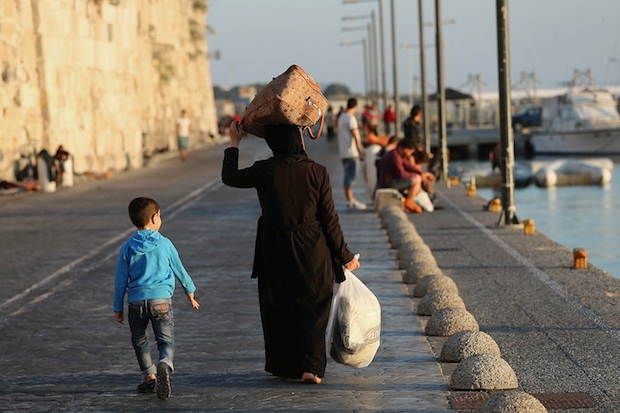Just a thought: what if Aylan Kurdi, the poor drowned three year old child whose picture changed Europe – we are told – when it comes to the fate of Syrian refugees, had been, say, Afghan rather than Syrian? Or Eritrean, or indeed Pakistani? Quite possible, you know. Perhaps half of the migrants coming to Europe across the Mediterranean are not actually Syrian. Many of them are now arriving in German towns, expecting, and receiving, welcome and the promise of residency but may in fact be sent packing if the Germans stick to the letter of their bending of the Dublin Agreement. Would our entire foreign and asylum policy been changed, as we are told it has been, as a result of the PM’s response to this little boy’s fate, or – as some observers suggested – SamCam’s response, if he’d been from one of those less favoured nations? Would the public have felt moved to offer, like Bob Geldof, rooms in their homes for a refugee family if he hadn’t been Syrian? I think not. The story would then have been a bit more nuanced, wouldn’t it? More about the flight from bad politics and poverty, than war.
Actually, if we are to seek first causes for the death of this child – and his brother and mother – from Kobani, perhaps we should go back a bit. A year ago this day week, the canton of Kobani where they lived, and dozens of its villages first fell to Isis, after a massive onslaught – resisted largely by the Kurds who live in many of those villages – using rockets, artillery and tanks. Most of us can remember just how it was that Isis came into possession of that heavy weaponry. It was after they walked into Mosul a few weeks previously, thereby taking possession not just of the central bank but of one of the Iraqi Army’s biggest arsenals of US weapons, after the Iraqi army simply ran away.
And why did they run away? Well, possibly because, as a force, they had, arguably, a good deal less morale and singleness of purpose than the Iraqi army had before it was disbanded and reformed by the coalition after Saddam. So, if we’re unravelling the reasons why this child died, I think it’s a bit more complicated than a want of compassion for refugees. My own view is that if we’d responded a good deal more robustly to the initial IS onslaught, then we wouldn’t be dealing with quite so many refugees now. And to carry on with this Russian doll-style approach to the cause question, why didn’t we see IS coming? I remember exactly where I was the day Mosul fell – at the Excel centre, watching Angelina Jolie and William Hague launch their excellent initiative against sexual violence in war, which of course we all support. It’s just one of those ironies that an awful lot more sexual violence happened as a result of the success of the IS advance while our eyes were off the ball.
Given that our foreign and asylum policy is now apparently determined by visual images, it’s a pity, isn’t it, that the unfortunate Yazidis didn’t grasp the crucial importance of getting those critical images when their young and little girls were getting parcelled out and raped by IS fighters after their villages fell. That might have made all the difference to galvanising a western response to IS, possibly involving Michelle Obama and Hillary Clinton. Just one picture of a little girl about to be violated might have done the trick… rather than the academic, fuddy duddy arguments about genocide (and I’d say the IS treatment of the Yazidis amounts to genocide in the most precise sense of the definition, which we are bound to prevent). Or perhaps a really good, 9/11 style picture of some unfortunate victim of IS – a gay man,perhaps – getting shoved off a tall building, maybe in mid-fall. But as Brendan O Neill has pointed out, in the world of visual emotional politics, nothing beats a dead baby or toddler. It’s the culmination of the trend evident during the Yugoslav conflict, whereby an event was only really true or at least only really influential, if it was recorded by CNN.
Tomorrow the PM will announce in the Commons how many refugees Britain will take in – 15,000 according to some reports, 20,000 according to others. And this is of course directly contrary to his perfectly coherent policy of a week ago, helping refugees in camps near Syria. This about-turn has happened because we’ve worked ourselves up into a state about Aylan Kurdi, or rather his picture. And if our policy is to be determined by pictures of dead babies, you know what – there’s going to be more; he wasn’t the only child to drown en route to Europe. But they’ll be false images. Most refugees – and certainly the overwhelming majority of those who make it to Europe – aren’t toddlers. They’re young men. And once they come here, they are unlikely to return.
There is a humanitarian case for taking Syrian refugees here, but only if they are then returned home at the end of the conflict to help rebuild the country. But you know what? They won’t go back. Once in Germany or Sweden or indeed here, the likelihood of them voluntarily returning to rebuild, say, Aleppo, is slim to nil, unlike the case if they were living in a camp in Lebanon. Lots of people came here from the war in the former Yugoslavia; I know hardly any who’ve gone back, except on holidays. A policy of humane returns could be a quid pro quo for an asylum policy, but it won’t happen.
Meanwhile, as the leader of Kent county council pointed out to Bob Geldof, there are lots of refugee families already in Britain seeking homes other than bed and breakfast accommodation. And as I say, there are an awful lot of people drawn by inexorable economic osmosis to Western Europe who are also part of that human tide coming from north Africa. Are we going to open our homes to them too? I think not. We’re compassionate all right, but not quite sure what the limits of compassion are. That’s picture politics for you.







Comments